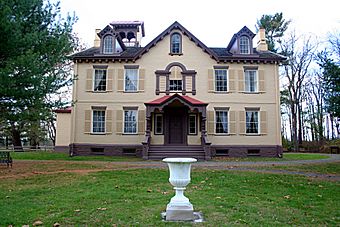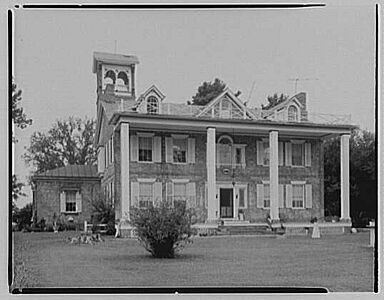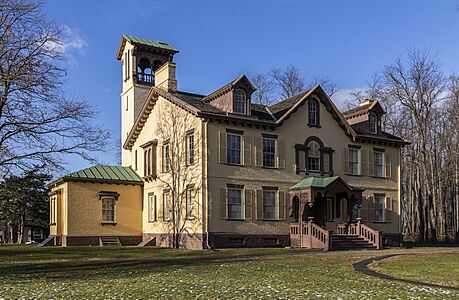Martin Van Buren National Historic Site facts for kids
|
Lindenwald
Martin Van Buren National Historic Site |
|

Front of the house facing the Albany Post Road
|
|
| Location | Town of Kinderhook, Columbia County, New York |
|---|---|
| Nearest city | Hudson, New York |
| Area | 125 acres (51 ha) |
| Built | 1797 |
| Architect | Peter Van Ness, Richard Upjohn |
| Architectural style | Federal; Gothic Revival |
| Visitation | 13,617 (2004) |
| Website | Martin Van Buren National Historic Site |
| NRHP reference No. | 66000510 (original) 12000406 (increase) |
Quick facts for kids Significant dates |
|
| Added to NRHP | October 15, 1966 |
| Boundary increase | July 11, 2012 |
| Designated NHL | July 4, 1961 |
| Designated NHS | October 26, 1974 |
The Martin Van Buren National Historic Site is a special place in Columbia County, New York. It is managed by the National Park Service of the United States. This site is about one mile south of the village of Kinderhook. It is also about 125 miles north of New York City.
This historic site protects Lindenwald, a large estate. Lindenwald was once the home of Martin Van Buren. He was the eighth president of the United States. Van Buren bought the 36-room mansion in 1839 while he was still president. It became his home and farm from 1841 until he passed away in 1862.
Contents
Lindenwald: Home of a President
A President's Home
Martin Van Buren helped start the Democratic Party. He bought Lindenwald and about 125 acres of land in 1839. He paid $14,000 for it. This was a lot of money back then!
Van Buren did not move into the house right away. He moved in during 1841. This was after he lost his bid for a second term as president. William Henry Harrison won the election in 1840. Van Buren's four sons, Abraham, John, Martin Jr., and Smith, all had rooms in the mansion.
Before Van Buren owned it, the Van Ness family lived there. The famous writer Washington Irving wrote parts of his books A History of New York and Sketch Book at this home. Irving and Van Buren later became good friends.
Running for President from Home
Martin Van Buren ran two presidential campaigns from Lindenwald. In 1844, he tried to get the Democratic nomination for president. He directed his campaign from the estate. However, he did not win the nomination that year. James Knox Polk became the nominee and later president.
In 1848, Van Buren ran for president again. He was part of a new group called the Free Soil Party. This party was against slavery spreading into new territories. He led this campaign from Lindenwald too. His campaign took enough votes from the Democratic candidate, Lewis Cass. This helped Zachary Taylor, the Whig candidate, win the election.
What's in a Name?
Van Buren named his estate Lindenwald. This name is German for "linden forest." He chose it because of the many American Linden trees. These trees lined the old Albany Post Road. This road is still in front of the house today. Some new Linden trees have been planted there too.
Martin Van Buren lived at Lindenwald until he died. He passed away on July 24, 1862, when he was 79 years old.
A Special Place in History
Lindenwald was recognized as a National Historic Landmark in 1961. This means it is a very important place in American history.
The Martin Van Buren National Historic Site was officially created on October 26, 1974. Today, the National Park Service takes care of Lindenwald. They help protect it for everyone to learn from and enjoy.
Visiting Lindenwald Today
The site is located on New York State Route 9H. It is about two miles south of Kinderhook, New York. There is a visitor center run by the National Park Service. You can learn a lot about Martin Van Buren and his home there.
If you want to see inside the Lindenwald mansion, you must take a tour. A park ranger will guide you through the house. For safety reasons, visitors cannot go up into the tower. The grounds around the house have signs. These signs tell you more about the estate's history.
In Van Buren's time, there were two small gatehouses. One was to the north and one to the south. The north gatehouse was taken down in the 1950s. You can still see its stone foundation today.
Images for kids
More to Explore




